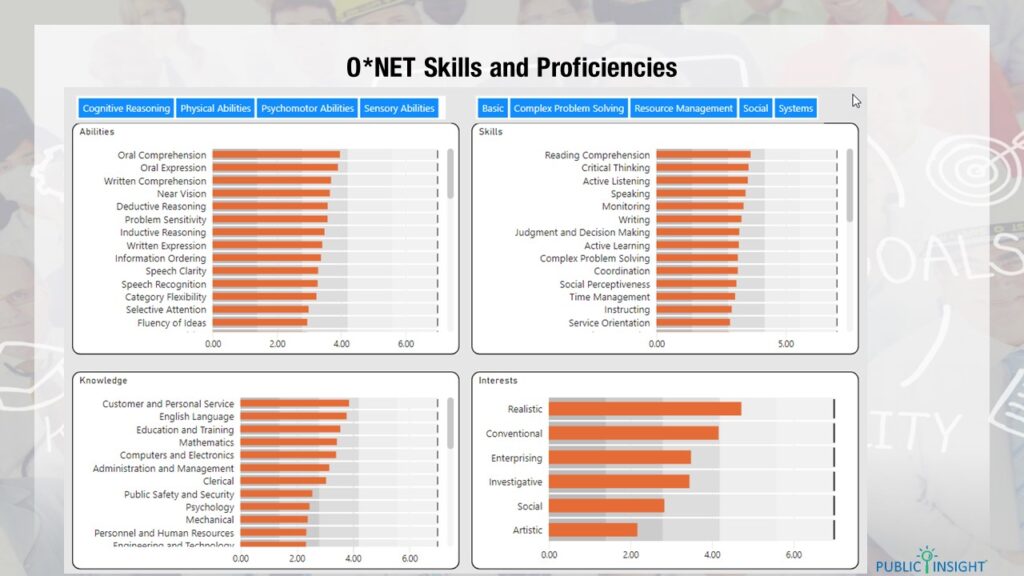A Closer Look At Job Skills List Data Sources
Few would argue that skills are a key driver in bridging the gap in job supply and demand, however it is challenging to get job skills list data. In our most recent jobs report webinar, 97% of career and workforce development attendees said that skills data is somewhat or extremely important in the career planning process. Yet skills are elusive in their meaning and there is not a single standard for identifying skills. Recruiters and staffing professionals can do a better job of targeting, and career planning professionals can do a better job of advising by understanding which job skills are in demand.
There are several standard sources of job skills lists data that are available in the public domain and there are different ways that we can extrapolate skills from existing job posting platforms. Let’s cover each of these options.
/wp-content/uploads/2020/10/skills-683×1024.jpg
O*NET
The Occupational Information Network or O*NET is a free online database that contains hundreds of occupational definitions to help students, job seekers, businesses and workforce development professionals to understand the current state of work in the United States. It is helpful to think of O*NET in two ways.
Occupation Clusters
O*NET extends the current Standard Occupational Classification (SOC) taxonomy to include several hundred additional occupations. In addition, O*NET categorizes these occupations into various clusters.
- Career Clusters
- Industries
- Green Economy
- STEM
- Job Family
Occupation Descriptors
O*NET provides ways of finding and exploring occupations based on certain characteristics or descriptors.
- Abilities
- Knowledge
- Interests
- Work Activities
- Technology Skills & Tools
- Skills
Both clusters and descriptors are visualized in the Insight for Work platform. For example, common descriptors are visualized as bullet charts as shown below.
Occupational Requirements Survey
The Occupational Requirements Survey (ORS) is a product of the Bureau of Labor Statistics (BLS). The ORS provides job-related information regarding physical demands; environmental conditions; education, training, and experience; as well as cognitive and mental requirements for jobs in the U.S. economy. ORS is a working arrangement with the Social Security Administration and the data is used predominantly for disability programs. You see this in the types of data reported, which is mainly around mental and physical acuity. The ORS survey data was last published in May 2020 for the 2019 survey. Types of information included in the ORS include:
Cognitive and Mental Requirements
- Interaction with the General Public
- Problem Solving
- Work Pace
Education, Training, and Experience
- Licensed Credentials
- Literacy Required
- Prior Work Experience
Environmental Conditions
- Extreme Heat or Cold
- Wetness
- Noise Intensity
Physical Conditions
- Vision
- Sitting or Standing
- Lifting or Carrying

Using Titles vs. Occupations
Both O*NET and ORS are based on the Standard Occupational Classification (SOC) system. There are currently just under 1,000 occupations in this taxonomy. Descriptors within the SOC system tend to be broad. For example, O*NET Abilities include oral comprehension or problem sensitivity. O*NET published hot technology skills include software tools and applications like Microsoft office applications that go across many different occupations.
Titles afford a much higher level of granularity. By using title, we can drill down to a lot more detail. For example, software applications could extend to a specific certification or a specific job. For example, a title of JAVA Developer could include Sun or AWS certification.
Indeed is a Fertile Ground for a Job Skills List
Indeed provides several ways to harvest skills from its platform.
Assessments
Indeed Assessments provides over 150 standardized assessments to benchmark job candidates. Employers can also customize additional assessments. Over 7,000 assessments are available in the Insight for Work platform.
Candidates are graded on assessments using a proficiency level on a descending scale.
- Expert
- Highly Proficient
- Proficient
- Familiar
- Completed
In Insight for Work, Indeed Assessments are visualized using a 100% bar chart that breaks down the results by expertise. In addition to filtering assessments by title, you can also apply regional filters (i.e. how many in each metro area are experts in computer programming).
Salary Skill Requirements
Indeed provides lists of common skills that are associated with specific job titles. Because job titles can vary widely, we have standardized to the most common job titles.
Resumé Listed Skills
Finally, job seekers will list skills as part of their posted resumés. We have curated these skills into lists of ranked skills based on how often they appear in resumés. Because a given skill can appear in multiple ways, it requires continuing refinement in the curation process to consolidate like skills.
About Insight for Work
Insight for Work is an analysis platform for anyone needing easy and fast access to jobs and labor market data. It integrates and combines data from job postings, hiring company profiles and ratings, compensation and benefit surveys, applicant and resumé profiles, and government agency publications with the power of the Microsoft® Power BI. Instantly analyze occupation, industry, and company opportunities and trends to evaluate strategies and programs and prioritize resources. Reports can be easily created and exported. Recruiters and staffing professionals can offer more value to clients and workforce or educational programs can be more competitive and on trend with the insights provided in the Insight for Work platform.










